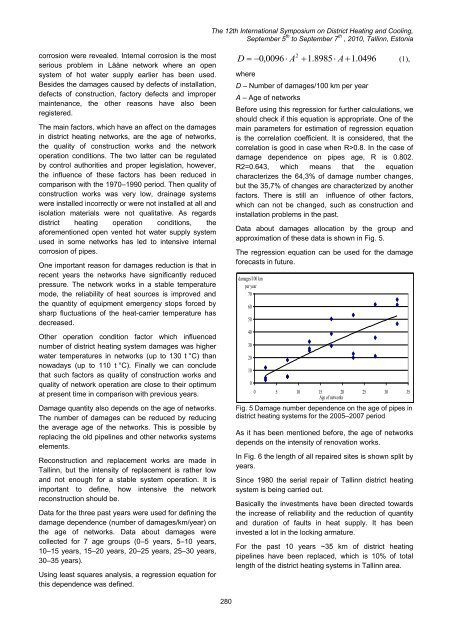12th International Symposium on District Heating and Cooling
12th International Symposium on District Heating and Cooling
12th International Symposium on District Heating and Cooling
You also want an ePaper? Increase the reach of your titles
YUMPU automatically turns print PDFs into web optimized ePapers that Google loves.
The <str<strong>on</strong>g>12th</str<strong>on</strong>g> <str<strong>on</strong>g>Internati<strong>on</strong>al</str<strong>on</strong>g> <str<strong>on</strong>g>Symposium</str<strong>on</strong>g> <strong>on</strong> <strong>District</strong> <strong>Heating</strong> <strong>and</strong> <strong>Cooling</strong>,September 5 th to September 7 th , 2010, Tallinn, Est<strong>on</strong>iacorrosi<strong>on</strong> were revealed. Internal corrosi<strong>on</strong> is the mostserious problem in Lääne network where an opensystem of hot water supply earlier has been used.Besides the damages caused by defects of installati<strong>on</strong>,defects of c<strong>on</strong>structi<strong>on</strong>, factory defects <strong>and</strong> impropermaintenance, the other reas<strong>on</strong>s have also beenregistered.The main factors, which have an affect <strong>on</strong> the damagesin district heating networks, are the age of networks,the quality of c<strong>on</strong>structi<strong>on</strong> works <strong>and</strong> the networkoperati<strong>on</strong> c<strong>on</strong>diti<strong>on</strong>s. The two latter can be regulatedby c<strong>on</strong>trol authorities <strong>and</strong> proper legislati<strong>on</strong>, however,the influence of these factors has been reduced incomparis<strong>on</strong> with the 1970–1990 period. Then quality ofc<strong>on</strong>structi<strong>on</strong> works was very low, drainage systemswere installed incorrectly or were not installed at all <strong>and</strong>isolati<strong>on</strong> materials were not qualitative. As regardsdistrict heating operati<strong>on</strong> c<strong>on</strong>diti<strong>on</strong>s, theaforementi<strong>on</strong>ed open vented hot water supply systemused in some networks has led to intensive internalcorrosi<strong>on</strong> of pipes.One important reas<strong>on</strong> for damages reducti<strong>on</strong> is that inrecent years the networks have significantly reducedpressure. The network works in a stable temperaturemode, the reliability of heat sources is improved <strong>and</strong>the quantity of equipment emergency stops forced bysharp fluctuati<strong>on</strong>s of the heat-carrier temperature hasdecreased.Other operati<strong>on</strong> c<strong>on</strong>diti<strong>on</strong> factor which influencednumber of district heating system damages was higherwater temperatures in networks (up to 130 t °C) thannowadays (up to 110 t °C). Finally we can c<strong>on</strong>cludethat such factors as quality of c<strong>on</strong>structi<strong>on</strong> works <strong>and</strong>quality of network operati<strong>on</strong> are close to their optimumat present time in comparis<strong>on</strong> with previous years.Damage quantity also depends <strong>on</strong> the age of networks.The number of damages can be reduced by reducingthe average age of the networks. This is possible byreplacing the old pipelines <strong>and</strong> other networks systemselements.Rec<strong>on</strong>structi<strong>on</strong> <strong>and</strong> replacement works are made inTallinn, but the intensity of replacement is rather low<strong>and</strong> not enough for a stable system operati<strong>on</strong>. It isimportant to define, how intensive the networkrec<strong>on</strong>structi<strong>on</strong> should be.Data for the three past years were used for defining thedamage dependence (number of damages/km/year) <strong>on</strong>the age of networks. Data about damages werecollected for 7 age groups (0–5 years, 5–10 years,10–15 years, 15–20 years, 20–25 years, 25–30 years,30–35 years).Using least squares analysis, a regressi<strong>on</strong> equati<strong>on</strong> forthis dependence was defined.2D 0,0096A 1.8985A 1.0496(1),whereD – Number of damages/100 km per yearA – Age of networksBefore using this regressi<strong>on</strong> for further calculati<strong>on</strong>s, weshould check if this equati<strong>on</strong> is appropriate. One of themain parameters for estimati<strong>on</strong> of regressi<strong>on</strong> equati<strong>on</strong>is the correlati<strong>on</strong> coefficient. It is c<strong>on</strong>sidered, that thecorrelati<strong>on</strong> is good in case when R>0.8. In the case ofdamage dependence <strong>on</strong> pipes age, R is 0.802.R2=0.643, which means that the equati<strong>on</strong>characterizes the 64,3% of damage number changes,but the 35,7% of changes are characterized by anotherfactors. There is still an influence of other factors,which can not be changed, such as c<strong>on</strong>structi<strong>on</strong> <strong>and</strong>installati<strong>on</strong> problems in the past.Data about damages allocati<strong>on</strong> by the group <strong>and</strong>approximati<strong>on</strong> of these data is shown in Fig. 5.The regressi<strong>on</strong> equati<strong>on</strong> can be used for the damageforecasts in future.damages/100 kmper year7060504030201000 5 10 15 20 25 30 35Age of networksFig. 5 Damage number dependence <strong>on</strong> the age of pipes indistrict heating systems for the 2005–2007 periodAs it has been menti<strong>on</strong>ed before, the age of networksdepends <strong>on</strong> the intensity of renovati<strong>on</strong> works.In Fig. 6 the length of all repaired sites is shown split byyears.Since 1980 the serial repair of Tallinn district heatingsystem is being carried out.Basically the investments have been directed towardsthe increase of reliability <strong>and</strong> the reducti<strong>on</strong> of quantity<strong>and</strong> durati<strong>on</strong> of faults in heat supply. It has beeninvested a lot in the locking armature.For the past 10 years ~35 km of district heatingpipelines have been replaced, which is 10% of totallength of the district heating systems in Tallinn area.280
















